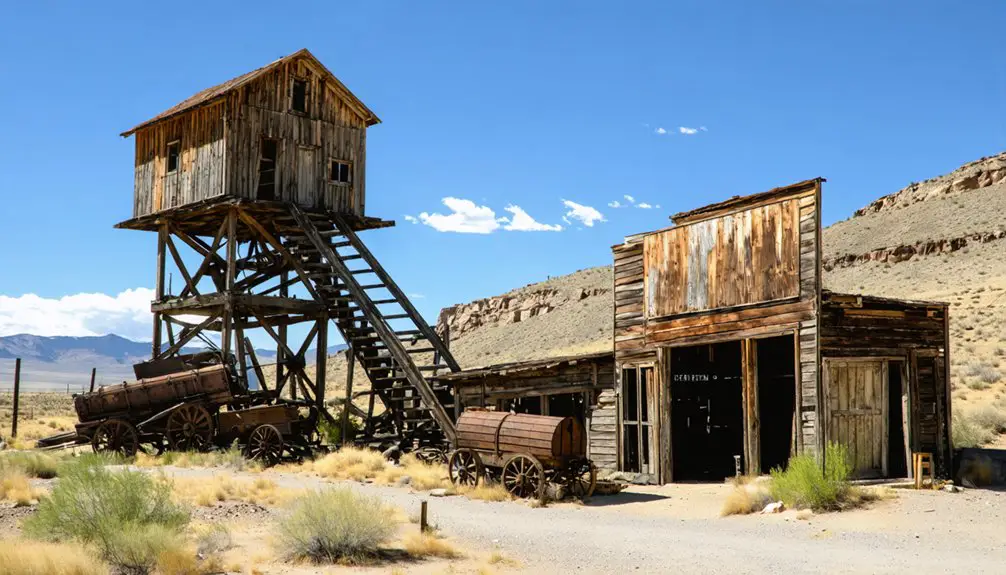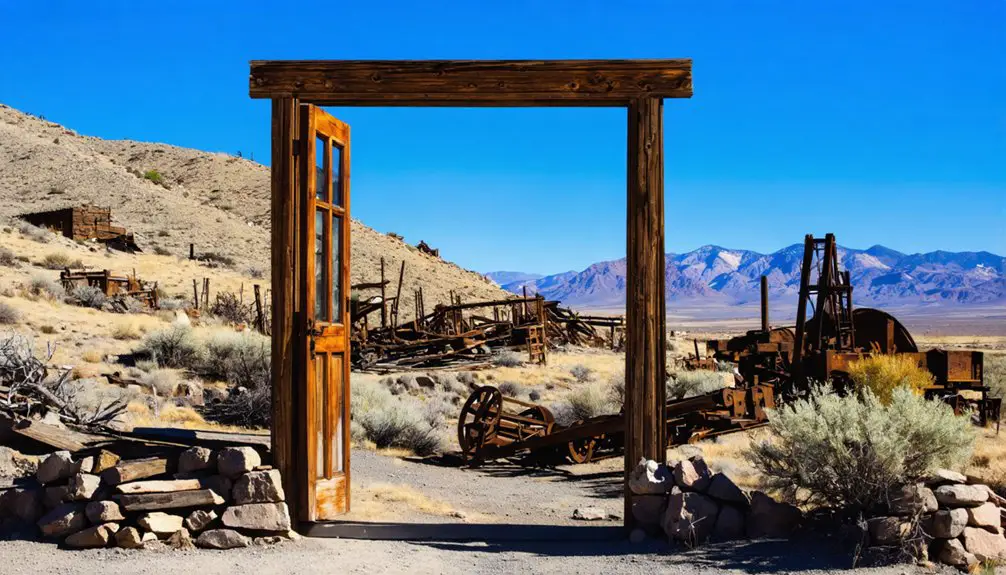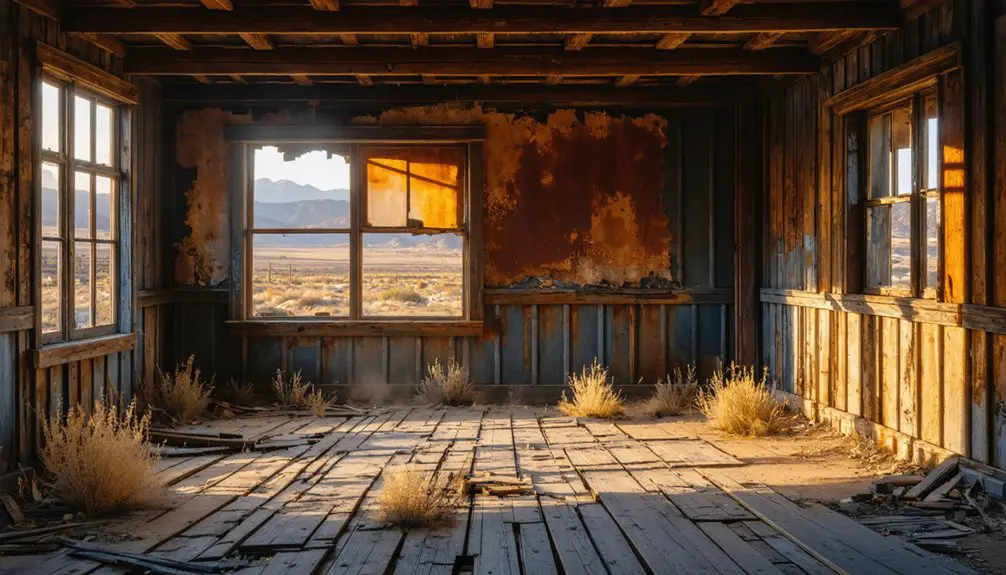You’ll find Ruby Hill’s mining legacy in Nevada’s Eureka Mining District, where gold-silver-lead deposits sparked a boomtown in 1864. The population soared to 2,500 by 1878, supporting 900 miners, a theater, brewery, and two restaurants. After the 1880s decline in ore production and a devastating 1910 flood destroyed rail infrastructure, Ruby Hill transformed into a ghost town. The well-preserved 1870s mining ruins along the canyon hold countless stories of boom-and-bust americana.
Key Takeaways
- Ruby Hill was a thriving Nevada mining town that peaked in 1878 with 2,500 residents and nearly 900 employed miners.
- The town flourished after rich gold-silver-lead deposits were discovered in 1864, leading to extensive mining operations.
- Infrastructure included a railroad, theater, brewery, two restaurants, and multiple churches during its prosperous years.
- Population declined drastically to 700 by 1885 due to depleting ore deposits, with final mining operations ceasing in 2002.
- Historic mining structures from the 1870s still remain along the canyon, protected by federal and state preservation laws.
Early Discovery and Mining Origins
While minimal mining activity initially occurred in the Eureka Mining District, the discovery of Ruby Hill’s rich gold-silver-lead deposits in 1864 marked the beginning of a significant mining era.
You’ll find the real breakthrough came in 1865 when an indigenous person revealed mineral-rich rock to prospectors Owen Farell, M.G. Cough, and Alonzo Monroe for just $10.
The site’s mineral discoveries expanded in 1869 when Cornish miners found ferruginous outcroppings about 2.5 miles west of Eureka township.
The arrival of Cornish miners in 1869 led to crucial discoveries of iron-rich deposits near Eureka, expanding the region’s mineral wealth.
Mining techniques advanced rapidly after Major W.W. McCoy developed a specialized furnace for processing oxidized ores.
The Buckeye and Champion mines were established first, followed by the Richmond and Tip-Top claims. The area required careful disambiguation of claims to prevent overlapping mining rights.
These early operations laid the foundation for Ruby Hill’s prominence, named after the distinctive “ruby silver” found in the area. The Holly mine emerged as the region’s most successful operation, producing 67,271 tons of valuable ore.
Life in a Bustling Mining Town
During Ruby Hill’s peak in the late 1870s, you’d find nearly 900 miners working the rich gold, silver, and lead deposits using the innovative Iron Reduction Process, while relying on the Eureka and Palisade Railroad to transport their valuable ores.
You could join your fellow townspeople at the local theater, brewery, or one of two restaurants after work, where the tight-knit community of 2,500 residents gathered to socialize and unwind.
The town’s vibrant social fabric included a miner’s union that organized workforce activities, churches that served as community hubs, and a local newspaper that kept you informed through the Mining Report, later known as the Mining News.
The miners primarily extracted silver and gold, with some operations yielding ore worth over one hundred dollars per ton.
Daily Mining Operations
As Ruby Hill reached its peak population of 2,500 in 1878, over 900 miners powered the town’s thriving mining operations through a complex network of underground workings.
The mining machinery included station pumps and electrical equipment, while workforce management focused on coordinating shifts across multiple mines like Eureka Consolidated and Richmond.
Your daily mining experience would’ve included:
- Operating heavy machinery and pumps in underground tunnels
- Maintaining safety protocols across different mining levels
- Processing extracted ore through various stages of refinement
- Collaborating with specialized contractors for construction and equipment maintenance
The mine’s sediment-hosted gold deposits made it a significant producer within Nevada’s mining industry.
You’d find yourself working alongside both company employees and independent prospectors who leased land to search for ore.
The mines operated under strict safety standards, with later operations like Homestake Mining Company earning recognition for their excellent safety record in the late 1990s.
Community Social Activities
Beyond the daily grind of mining operations, Ruby Hill’s social fabric wove together through a rich network of community institutions and gathering spaces.
You’d find residents congregating at the local brewery, attending theatrical performances, or participating in church-sponsored events that shaped the town’s cultural rhythm. The two newspapers provided diverse perspectives on local issues. The community gatherings often centered around the town’s multiple churches, which served dual roles as spiritual centers and social hubs.
The town’s vibrant cultural events included theatrical shows at the local theater, while newspapers like the Mining Report kept you informed about local happenings.
The miners’ union fostered solidarity through organized meetings and advocacy efforts. Despite the harsh realities of mining life, you’d experience a strong sense of community through the schools, churches, and social establishments that united Ruby Hill’s 2,500 residents during its peak years.
Entertainment and Recreation
While the rugged terrain and demanding work of mining dominated daily life, Ruby Hill offered its 2,500 residents a vibrant array of entertainment options.
You’d find recreational venues scattered throughout town, from the bustling Miners’ Union Hall to the local theater and brewery. The narrow-gauge “3 x 3” railroad connected you to nearby Eureka for additional entertainment opportunities.
The mining camp’s evolution into a thriving community by 1878 supported a diverse entertainment scene.
Sitting at an elevation of 6,916 feet, the town provided a unique mountain setting for its entertainment venues.
Key mining entertainment features included:
- The Miners’ Union Hall hosting social gatherings and community events
- Multiple saloons serving as popular social hubs for miners
- Two newspapers, the Mining Report and Mining News, keeping you informed of local happenings
- Churches of various denominations offering community events beyond worship
When mining declined in the 1880s, entertainment options dwindled as the population dropped below 700.
The 1910 flood washed away most remaining venues.
Ruby Hill’s Golden Age
You’ll discover that Ruby Hill’s golden age in the late 1870s brought unprecedented wealth, with over 900 miners employed and the population reaching 2,500 residents.
The town’s prosperity fueled a rich social scene featuring theaters, churches, and two newspapers, while a brewery provided entertainment for the hardworking miners.
The 1875 arrival of the Ruby Hill Railroad strengthened the town’s commercial ties, enabling efficient ore transport to Eureka’s smelters and boosting the local economy through increased trade opportunities.
Mining Wealth and Prosperity
During Ruby Hill’s peak prosperity from the early 1870s to 1885, the mining camp transformed into a thriving community of 2,500 residents, powered by rich deposits of silver and gold.
The town’s economic fluctuations mirrored the success of its mining techniques, from underground tunnels to advanced drilling operations. The site’s cut and fill mining method proved effective for extracting valuable minerals from the region’s limestone deposits.
You’ll discover these key developments that shaped Ruby Hill’s wealth:
- The Cow and Calf Mine’s 1871 discovery sparked the initial silver and gold boom.
- Four major mines sustained production after smaller operations depleted.
- The Ruby Hill Railroad’s 1875 completion revolutionized ore transport.
- Mining companies invested in employee housing and infrastructure.
The district’s success attracted major players like RichmondEureka and Newmont Mining, though by 1885, the population had dropped to 700 as accessible ore deposits diminished.
Social Life and Entertainment
As Ruby Hill reached its peak population of 2,500 residents in 1878, the town’s social fabric wove together a rich tapestry of cultural institutions and entertainment venues.
You’d find the Miners’ Union Hall at the heart of community life, hosting labor meetings and social gatherings in its dedicated theater space. The town supported two newspapers, multiple churches, and numerous saloons where you could enjoy card games and live music.
Cultural events flourished through various social clubs and fraternal organizations, while the theater offered regular performances.
Whether you were a miner, business owner, or family member, you’d have access to schools, stores, and a brewery. The Mining Report (later Mining News) kept you informed of local happenings, fostering a strong sense of community among Ruby Hill’s diverse residents.
Transportation and Trade Growth
While Ruby Hill’s growth hinged on multiple factors, the arrival of the Ruby Hill Railroad in 1875 marked a pivotal transformation in the town’s industrial capabilities.
The transportation evolution brought dramatic changes to trade dynamics, helping the population surge to 2,500 by 1878. You’ll find that this period represented Ruby Hill’s peak industrial era, characterized by:
- Swift ore transport to Eureka’s smelters, revolutionizing mining efficiency
- Regular imports of essential supplies, from miners’ tools to daily necessities
- Development of two newspapers, reflecting the town’s commercial sophistication
- Community-driven road construction efforts between mining districts
Despite these advances, the transportation infrastructure remained vulnerable.
When the railroad washed out in 1910, it dealt a severe blow to Ruby Hill’s commercial viability, contributing to its eventual decline into a ghost town.
Transportation and Infrastructure
The transportation network of Ruby Hill centered primarily on the Ruby Hill Railroad, completed in 1875 to move ore from the hilltop mines to Eureka’s smelters three miles away. Daily trains, powered by Baldwin locomotives, hauled ten 6-ton ore cars and even included a passenger coach for residents’ convenience. After the railroad’s acquisition in 1875, the E&P Railroad purchased the line to expand operations.
You’ll find that transportation challenges shaped Ruby Hill’s infrastructure evolution. While miners built connecting roads between camps, these remained rough and unsuitable for heavy freight. The post office, newspapers, and local businesses relied on these basic roads for supplies and communication until 1901.
The devastating 1910 flash flood destroyed vital rail infrastructure, effectively ending revival efforts. Despite 1960s exploration attempts using advanced technology, no commercially viable ore was found to justify rebuilding the transportation network, contributing to Ruby Hill’s ghost town status.
Decline of a Mining Empire

Following its peak population of 2,500 residents in 1878, Ruby Hill‘s mining empire entered a steep decline that would ultimately lead to its abandonment.
Economic downturns and mining regulations combined with other challenges to bring down this once-thriving community.
The story of Ruby Hill’s decline can be traced through these major events:
- Mine production faltered in the early 1880s, causing population to plummet to 700 by 1885
- A devastating 1910 storm destroyed critical railroad infrastructure
- Legal problems and equipment removal in the 1960s marked mining’s end
- Despite Homestake Mining’s 1997 revival attempt, operations ceased by 2002
You’ll find that while modern companies attempted to breathe new life into Ruby Hill, fluctuating gold prices and operational costs repeatedly challenged mining viability throughout its history.
Ghost Town Legacy
Today, abandoned structures and weathered remnants tell the story of Ruby Hill’s remarkable mining legacy, where a once-thriving population of 2,500 residents carved out their existence amid Nevada’s mineral-rich landscape.
The Ruby Hill Railroad connected these bustling mines to transport vital ore and supplies throughout the region. You’ll find traces of mining heritage in the surviving miner cabins, which showcase the evolution from canvas tents to wood and stone dwellings built before 1900.
The town’s rich cultural footprint lives on through preserved landmarks like the Miners’ Union Hall, churches, and industrial remnants including machinery buildings and water towers.
The devastating 1910 storm that destroyed the Eureka-Nevada railroad marked Ruby Hill’s final shift to a ghost town, but you can still explore these protected historical sites while respecting their significance through careful observation and photography.
Present-Day Exploration Guide

Located 2.6 miles west of Eureka, Nevada, Ruby Hill’s ghost town remains readily accessible to modern-day explorers via US Highway 50.
You’ll discover remnants of 19th-century mining infrastructure against typical Nevada arid terrain, with the modern Ruby Hill Mine serving as a useful landmark.
Essential exploration tips and safety precautions for your visit:
- Navigate using GPS coordinates (39°30’17″N, 115°59’10″W) and bring detailed maps, as signage is limited.
- Pack adequate water and supplies – there aren’t any maintained facilities on site.
- Watch for hazards like unstable structures and old mine shafts while exploring the ruins.
- Use Eureka town as your base camp, where you’ll find lodging, food, and knowledgeable locals who can enhance your ghost town adventure.
Historic Preservation Efforts
Under federal and state law, Ruby Hill’s historic structures and artifacts receive extensive protection aimed at preserving their cultural significance. The Nevada State Historic Preservation Office oversees compliance while volunteer monitors help prevent unauthorized removal of artifacts.
You’ll find mining ruins from the 1870s onward arranged in chronological order up the canyon, with many structures like ore bins remaining in surprisingly good condition.
However, preservation challenges arise from ongoing mining operations, particularly the large open-pit mine that threatens undiscovered historic features. To address these concerns, mining companies must conduct Environmental Assessments and work with stakeholders to develop mitigation strategies.
Modern mining operations pose risks to Ruby Hill’s hidden historic treasures, requiring careful assessment and collaboration to protect these irreplaceable sites.
Community involvement plays a crucial role through local volunteers who monitor site conditions and promote responsible tourism practices to protect Ruby Hill’s mining heritage.
Frequently Asked Questions
Are There Any Reported Ghost Sightings or Paranormal Activities in Ruby Hill?
You won’t find documented ghost encounters or paranormal investigations at this location. Research shows no credible reports of supernatural activity, unlike other Nevada ghost towns that have well-established haunted histories.
What Valuable Artifacts Have Been Discovered by Visitors to Ruby Hill?
Want to know what treasures lie in Ruby Hill? You’ll find gold rush artifacts like mining tools, silver ore specimens, and historically significant items including period newspapers, though removing these items isn’t permitted.
Can Visitors Stay Overnight or Camp Near Ruby Hill?
You can’t stay at Ruby Hill itself, but you’ll find camping options nearby at South Ruby Campground ($12/night), dispersed camping on public lands, or luxury accommodations at Ruby High Yurt.
What Safety Precautions Should Visitors Take When Exploring Ruby Hill?
With 60% of mining-related accidents involving falls, you’ll need proper safety gear including helmet, boots, and flashlight. Stay alert for wildlife, avoid unstable structures, and don’t explore shafts alone.
Which Months Offer the Best Weather Conditions for Visiting Ruby Hill?
You’ll find the best months are May through September, with May and September offering ideal weather patterns: temperatures around 70°F, minimal rainfall, moderate humidity, and extended daylight for exploration.
References
- https://www.darkvibestruecrime.com/post/nevada-ghost-towns-ruby-hill
- https://www.youtube.com/watch?v=URCCHIlWLes
- https://en.wikipedia.org/wiki/Ruby_Hill
- https://allaroundnevada.com/ruby-hill/
- https://westernmininghistory.com/towns/nevada/ruby-hill/
- https://www.rainesmarket.com/history-of-the-ruby-hill-area.html
- https://www.rainesmarket.com/ruby-hill-in-the-21st-century.html
- https://forgottennevada.org/sites/eureka.html
- https://pubs.usgs.gov/pp/0406/report.pdf
- http://www.ghosttownsusa.com/ruby2.htm



